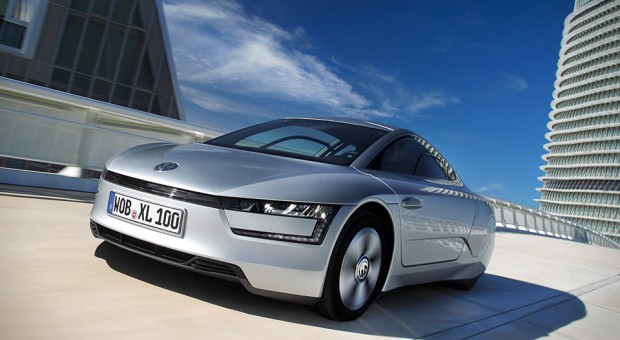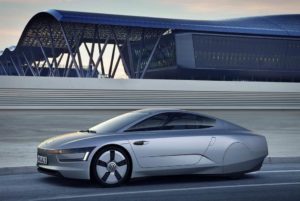
In February 2012, Volkswagen confirmed that it would build a limited series of XL1s starting in 2013.
The XL1 from Volkswagen is the most fuel-efficient production car in the world, with a European combined fuel consumption rating of 261 mpg. Thanks to its plug-in hybrid system, this two-seat vehicle can also cover up to 32 miles as a zero-emissions vehicle in all-electric mode.
Volkswagen to produce XL1 at its Osnabrück plant in Germany, using carbonfiber technology
The XL1 is an automotive standout that follows pure sports-car design principles: light weight (1953 pounds), exceptional aerodynamics (Cd 0.19), and a low center of gravity.
The prototype VW 1-Litre concept car was shown to the public in April 2002 when Dr. Ferdinand Piech, then Chairman of the Board of Management, drove the concept between Wolfsburg and Hamburg as part of the Volkswagen annual meeting of stockholders.
This super-efficient Volkswagen thus has the ability to cruise down the road at a constant 62 mph while using just 8.3 horsepower. In all-electric mode, the XL1 requires less than 0.1 kWh to cover more than a kilometer.
 The XL1 emits just 21 g/km of CO2, thanks to its high-tech lightweight design, aerodynamic efficiency, and a plug-in hybrid system consisting of a 47-hp two-cylinder TDI® engine, a 27-hp electric motor, a seven-speed DSG® dual-clutch automatic transmission, and a lithium-ion battery. The 261 mpg fuel consumption figure is a record that has not been achieved by any other vehicle to date, showing that Volkswagen is redefining what is technically feasible in the automotive industry. The XL1 also has a top speed of 99 mph and can accelerate from 0 to 62 mph in 12.7 seconds.
The XL1 emits just 21 g/km of CO2, thanks to its high-tech lightweight design, aerodynamic efficiency, and a plug-in hybrid system consisting of a 47-hp two-cylinder TDI® engine, a 27-hp electric motor, a seven-speed DSG® dual-clutch automatic transmission, and a lithium-ion battery. The 261 mpg fuel consumption figure is a record that has not been achieved by any other vehicle to date, showing that Volkswagen is redefining what is technically feasible in the automotive industry. The XL1 also has a top speed of 99 mph and can accelerate from 0 to 62 mph in 12.7 seconds.
The XL1 is the most aerodynamic production car ever, with a Cd of 0.19
Conceptually, the XL1 represents the third evolutionary stage of Volkswagen##Q##s 1-liter car strategy. When the new millennium was ushered in, Prof. Dr. Ferdinand Piëch, currently Chairman of the Supervisory Board of Volkswagen AG, formulated the visionary goal of putting into production a practical car that had combined fuel consumption of one liter per 100 km (235 mpg). In the two-seat XL1, this vision has become reality.
261 mpg combined fuel consumption was a vision — now it##Q##s a reality
Despite the tremendous efficiency of the XL1, the engineers and designers successfully came up with a body design which delivers more everyday utility than the two previous prototypes. In the L1, the 1-liter car that was shown in 2002 and 2009, the driver and passenger sat in a tandem arrangement for optimal aerodynamics; in the XL1, the two occupants sit slightly offset, side by side, almost like a conventional vehicle.
According to Volkswagen, the vehicle consumes 0.99 L/100 km (238 mpg-US),285mpg(imp), giving it a 650 km (404 mi) driving range on one tank of fuel.
The XL1 is 153.1 inches long, 65.6 in wide, and just 45.4 in tall. By comparison, a Volkswagen Polo is slightly longer (156.3 in) and wider (66.2 in), but is significantly taller (57.6 in). Even a purebred sports car like today##Q##s Porsche Boxster is 5.1 inches taller. The XL1 will look spectacular going down the highway — a car of the future, built for today.
SOURCE: Volkswagen of America




















